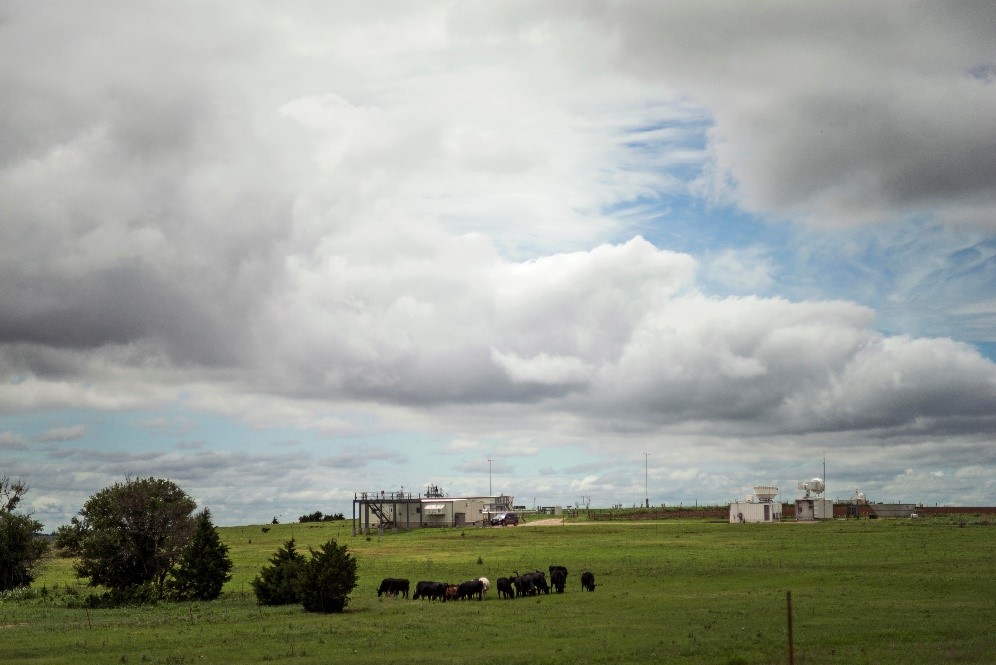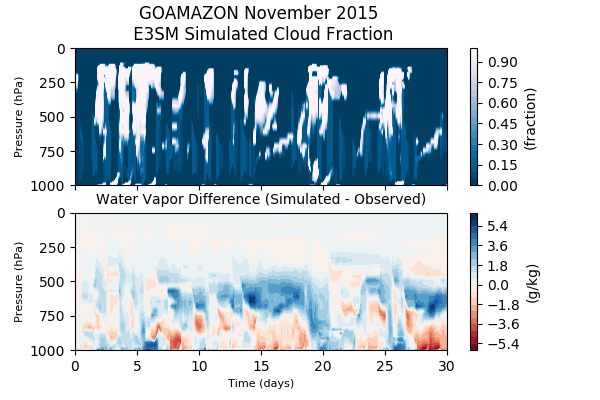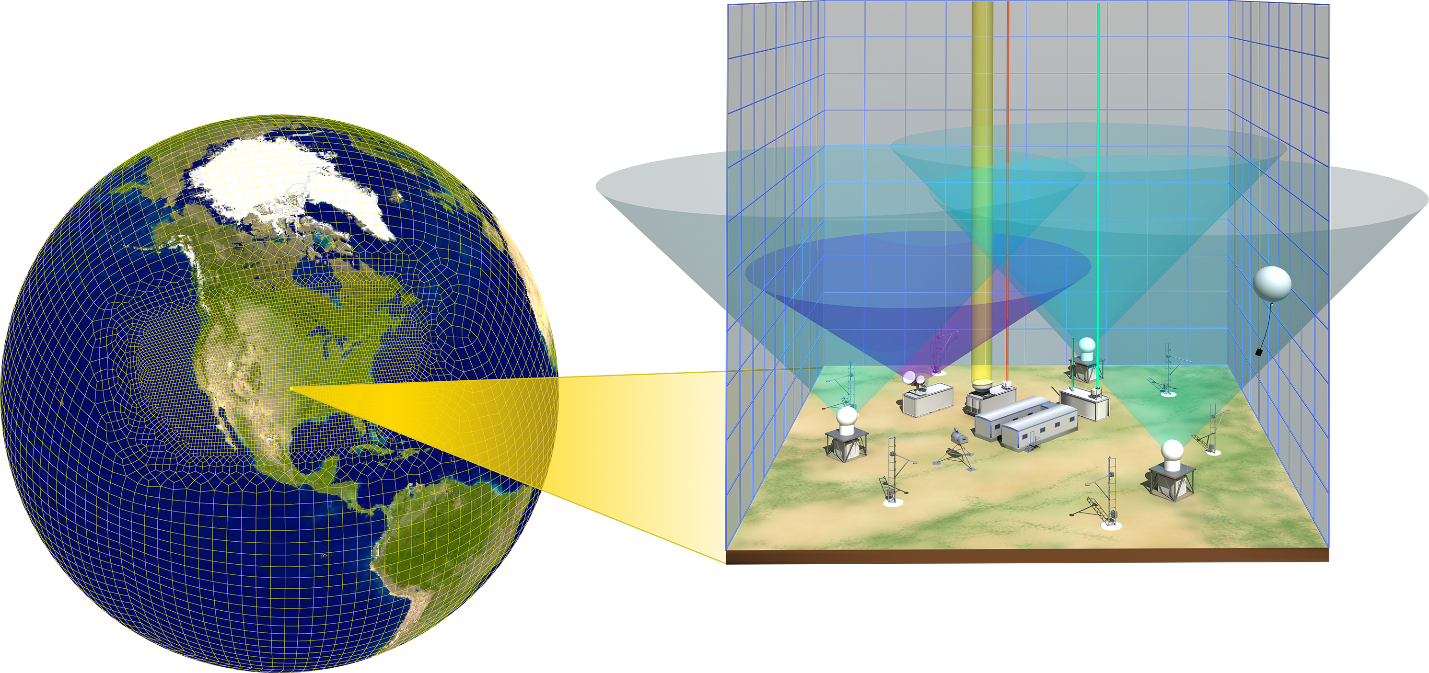ARM-ASR-E3SM Collaborations Bear Fruit With E3SM’s Single-Column Model
Published: 24 June 2019

Scattered across the prairies of north-central Oklahoma and southern Kansas, a collection of 50-plus scientific instruments points to the heavens. This is the Atmospheric Radiation Measurement (ARM) user facility’s Southern Great Plains atmospheric observatory, and those instruments are collecting data on radiation, clouds, aerosols (tiny particles in the air), and other atmospheric processes.
Here, and at ARM observatories and field campaigns across the globe, ARM instruments gather observational data required to power national and international research efforts related to earth system changes. A growing number of scientists are now making use of ARM data to better represent processes in earth system models.
Whether modeling a localized portion of an Antarctic ice sheet, an ocean, or the entire planet, earth system models segment areas of interest into a grid with individual cells that may range from just a few kilometers to several hundred kilometers in width.
“If you are looking to validate or improve a parameterization (a simplified representation) to be used in an earth system model, it helps to first test it locally. Constraining it over a specific location in a single-column model allows a more ‘apples-to-apples’ comparison of your simulation with observational data,” says Ruby Leung, chief scientist of the U.S. Department of Energy’s (DOE’s) Energy Exascale Earth System Model (E3SM) project. Leung is also an atmospheric scientist at Pacific Northwest National Laboratory in Richland, Washington.
A single-column model (SCM) encompasses a vertical column over one grid cell in a model from the surface to the top of the atmosphere. SCMs are configured from an earth system model to simulate physical processes in the atmosphere. Run in isolation, modelers can use SCMs to test if errors are coming from their parameterizations.
Leung notes that an SCM is a powerful tool for the development of model estimations and can also be used to understand errors and parametric uncertainty—all without a high computational cost.
“With a single-column model, you can prescribe the large-scale environment using observations—wind, moisture, and temperature, for example—thus helping to isolate the model-observation differences to limitations and uncertainties in the representations,” she says. “Using the E3SM SCM to test and evaluate parameterizations provides a more direct path to improving E3SM because all the atmospheric processes in the SCM are represented in the same manner as in E3SM.”
Researchers Breathe Life Into an Outdated Model

Peter Caldwell and Peter Bogenschutz, research scientists from Lawrence Livermore National Laboratory (LLNL) in California, took on the challenge of updating the single-column model that was ultimately built into E3SM.
“It had not been updated for several years, and frankly, it was broken,” says Caldwell. “So, when we took on the project for E3SM, our target was to make (the E3SM SCM) scientifically credible so that anyone who wants to use it can do so with confidence.”
Single-column models have been around for a long time and were popular among researchers in the past. Caldwell says that popularity waned because exciting results from the model would not always hold when applied to global simulations.
“One complaint users of single-column models have had is that occasionally improvements made in the single-column model haven’t translated to an improvement of the global model,” he says. “Our next target is to understand why and develop strategies to ensure that SCM results are good proxies for global model behavior.”
Caldwell and Bogenschutz worked closely with LLNL research scientists Shuaiqi Tang and Shaocheng Xie, who had received funding under ARM for several years to produce single-column-model forcings and comparison data sets for various ARM cases. The collaboration ensured that all ARM test cases would function accurately with the updated SCM code for E3SM.
“ARM has already played a very important role in creating these new cases for anyone to use,” says Caldwell. “Going forward, my hope is that the E3SM single-column model can be used as a vehicle for collaboration and communication between the observational community of ARM and the model development community of E3SM.”
ARM and the E3SM Single-Column Model

Most researchers supported by ARM and DOE’s Atmospheric System Research (ASR) program are familiar with single-column models, but—says ARM Technical Director Jim Mather—not many are aware that E3SM now has a single-column model, with code now available for download on GitHub.
“Along with the code, the E3SM library now includes a significant number of ARM cases spanning multiple locations and meteorological regimes,” says Mather. “This diverse case library provides an excellent opportunity for investigators to apply ARM data to the evaluation and development of the E3SM model.”
Mather says that ARM supports the evaluation and development of E3SM. “This single-column model provides a powerful way to do that,” he says. “The Climate Model Development and Validation (CMDV) projects represent another outstanding mechanism for ARM-ASR-E3SM collaborations. Customizing ARM data sets may also be valuable for E3SM and, in the future, I hope and expect that we will be developing virtual field campaigns around E3SM development needs.”
Getting the Most From the E3SM Single-Column Model
Caldwell contends that the E3SM SCM can be a valuable tool for the ARM, ASR, and E3SM research communities. “We have a scientifically validated and easy-to-use single-column model capability that can be a focus of collaboration and interaction between all three communities.”
Bogenschutz adds that the ever-expanding case library and data sets are making it easier than ever for researchers to integrate ARM data into their research and expand their research scope. “I don’t think people are aware that our case library has expanded. It offers them ARM cases that were previously not possible to run in a single-column model context. It’s really exciting.”
Caldwell encourages researchers to download the code and use it to help the model develop and improve.
“This is an opportunity to test your parameterization within the framework of E3SM,” he says. “It can be a valuable tool for seeing how observations compare to the model. Moreover, we would like the ARM community to come up with new ideas for more data sets that can be used to create more single-column model test cases or novel observations.”
Caldwell says the ASR community may be the main beneficiary of opportunities available with the E3SM single-column model and the data test cases already available.
“Included in these new case studies are the first multiyear SCM data sets,” he says. “These long cases are groundbreaking because they allow us to look at statistics of SCM behavior aggregated over specific climate regimes rather than reporting on model behavior from a single case.”
Keep up with the Atmospheric Observer
Updates on ARM news, events, and opportunities delivered to your inbox
ARM User Profile
ARM welcomes users from all institutions and nations. A free ARM user account is needed to access ARM data.


















